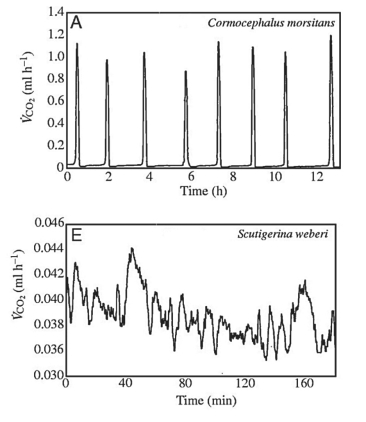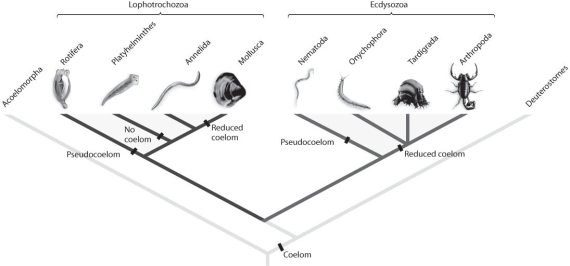A) nature of the body cavity
B) presence or degree of segmentation
C) number of germ layers present in embryonic development
D) method of feeding
E) way that the organism grows
G) A) and E)
Correct Answer

verified
Correct Answer
verified
Multiple Choice
Figure 33.2
Use the following information when answering the corresponding question(s) .
Many terrestrial arthropods exchange gases with their environments by using tracheae,tubes that lead from openings (called spiracles) in the animal's exoskeleton or cuticle directly to the animal's tissues.Some arthropods can control whether their spiracles are opened or closed;opening the spiracles allows the carbon dioxide produced in the tissues to travel down the tracheae and be released outside the animal.Klok et al.measured the carbon dioxide emitted over time (represented by VCO₂) by several species of centipedes.Figure 33.2 presents graphs of their results for two species,Cormocephalus morsitans and Scutigerina weberi.(C.J.Klok,R.D.Mercer,and S.L.Chown.2002.Discontinuous gas-exchange in centipedes and its convergent evolution in tracheated arthropods.Journal of Experimental Biology 205:1019-29. )
 -Look at the graph for Scutigerina weberi (note the scale of the y-axis) in Figure 33.2.What is the best interpretation of these results?
-Look at the graph for Scutigerina weberi (note the scale of the y-axis) in Figure 33.2.What is the best interpretation of these results?
A) The centipede had its spiracles open the entire time.
B) The centipede had its spiracles closed the entire time.
C) The centipede had its spiracles open when CO₂ emission peaked and closed when CO₂ emission was low.
D) The centipede had its spiracles closed when CO₂ emission peaked and open when CO₂ emission was low.
F) None of the above
Correct Answer

verified
Correct Answer
verified
Multiple Choice
Figure 33.2
Use the following information when answering the corresponding question(s) .
Many terrestrial arthropods exchange gases with their environments by using tracheae,tubes that lead from openings (called spiracles) in the animal's exoskeleton or cuticle directly to the animal's tissues.Some arthropods can control whether their spiracles are opened or closed;opening the spiracles allows the carbon dioxide produced in the tissues to travel down the tracheae and be released outside the animal.Klok et al.measured the carbon dioxide emitted over time (represented by VCO₂) by several species of centipedes.Figure 33.2 presents graphs of their results for two species,Cormocephalus morsitans and Scutigerina weberi.(C.J.Klok,R.D.Mercer,and S.L.Chown.2002.Discontinuous gas-exchange in centipedes and its convergent evolution in tracheated arthropods.Journal of Experimental Biology 205:1019-29. )
 -Compare the graphs in Figure 33.2 of CO₂ emission for Cormocephalus morsitans and Scutigerina weberi.What hypothesis can you make about each centipede's habitat?
-Compare the graphs in Figure 33.2 of CO₂ emission for Cormocephalus morsitans and Scutigerina weberi.What hypothesis can you make about each centipede's habitat?
A) C) morsitans lives in a habitat that provides more carbon dioxide than does S.weberi.
B) C) morsitans lives in a habitat with more predators than does S.weberi.
C) C) morsitans lives in a colder habitat than does S.weberi.
D) C) morsitans lives in a drier habitat than does S.weberi.
F) A) and D)
Correct Answer

verified
Correct Answer
verified
Multiple Choice
Among protostomes,which morphological trait has shown the most variation?
A) type of symmetry (bilateral vs.radial vs.none)
B) type of body cavity (coelom vs.pseudocoelom vs.acoelom)
C) number of embryonic tissue types (diploblasty vs.triploblasty)
D) direction of gastrulation (protostome vs.deuterostome)
F) B) and C)
Correct Answer

verified
Correct Answer
verified
Multiple Choice
What do all the Lophotrochozoa phyla discussed in the text have in common?
A) They feed using lophophores,specialized ciliated structures.
B) They have trochophore larvae,which swim with the aid of a ring of cilia.
C) They have members that reproduce sexually and members that reproduce asexually.
D) They grow by shedding an exoskeleton or cuticle.
F) B) and D)
Correct Answer

verified
Correct Answer
verified
Multiple Choice
What is not true of all arthropods?
A) They metamorphose during development.
B) They have jointed limbs.
C) They grow by molting.
D) They have segmented bodies.
E) They have an exoskeleton or cuticle.
G) D) and E)
Correct Answer

verified
Correct Answer
verified
Multiple Choice
When considering the wormlike phyla within the protostomes,which feature is most useful in distinguishing groups?
A) the type of body cavity
B) the presence or absence of a hemocoel
C) feeding structures or mouthparts
D) hydrostatic skeleton
F) B) and C)
Correct Answer

verified
Correct Answer
verified
Multiple Choice
Which of the following organisms would you expect to have the largest surface-area-to-volume ratio?
A) a rotifer
B) a mollusk
C) an annelid
D) an arthropod
E) a platyhelminth
G) C) and D)
Correct Answer

verified
Correct Answer
verified
Multiple Choice
You find a multi-legged animal in your garden and want to determine if it is a centipede or a millipede.You take the animal to a university where a myriapodologist quickly tells you that you've found a centipede.Which of the following may have allowed her to make this distinction?
A) segmentation
B) poison-filled glands
C) the total number of legs
D) egg-laying
E) molting
G) A) and D)
Correct Answer

verified
Correct Answer
verified
Multiple Choice
In adult arthropods,the hemocoel performs which of the following functions?
A) provides space for the internal organs to grow and function
B) forms a cavity to protect the visceral mass of organs
C) acts as a hydrostatic skeleton for mobility
D) secretes the exoskeleton
F) B) and D)
Correct Answer

verified
Correct Answer
verified
Multiple Choice
Which of the following do Nematoda and Arthropoda have in common?
A) The initial pore formed in the gastrula stage becomes the anus.
B) They are suspension feeders.
C) They grow by shedding their outer covering.
D) They are lophotrochozoans.
E) They have the same kind of unique,ciliated larvae.
G) A) and B)
Correct Answer

verified
Correct Answer
verified
Multiple Choice
Upon close inspection of movement in annelids and nematodes,you would notice an obvious difference.Nematodes tend to wriggle back and forth,while annelids tend to contract along their length as their girth swells and then thin out as they stretch.What anatomical feature explains this type of movement?
A) The annelids possess longitudinal muscle fibers that the nematodes lack.
B) The nematodes lack circular muscle fibers.
C) Nematodes lack a coelom.
D) Annelids have a highly specialized nervous system capable of more complex movements.
F) A) and C)
Correct Answer

verified
Correct Answer
verified
Multiple Choice
Figure 33.1
 -Refer to Figure 33.1.Suppose new molecular analyses indicated that the phylum Annelida had diverged from the arthropod lineage after Onychophora and Tardigrada.What would this imply about protostome evolution?
-Refer to Figure 33.1.Suppose new molecular analyses indicated that the phylum Annelida had diverged from the arthropod lineage after Onychophora and Tardigrada.What would this imply about protostome evolution?
A) Segmentation evolved only once within protostomes.
B) The annelid lineage gained and then lost the ability to molt.
C) The annelid lineage gained and then lost jointed limbs.
D) Segmentation evolved only once within protostomes;the annelid lineage gained and then lost the ability to molt.
E) Segmentation evolved only once within protostomes;the annelid lineage gained and then lost jointed limbs.
G) C) and D)
Correct Answer

verified
Correct Answer
verified
Multiple Choice
Which mollusk group can be described as having several calcium carbonate plates along their dorsal side?
A) bivalves
B) gastropods
C) chitons
D) cephalopods
F) A) and B)
Correct Answer

verified
Correct Answer
verified
Multiple Choice
Which one of these groups does not molt?
A) Crustaceans
B) Arthropods
C) Mollusks
D) Chelicerata
E) Nematoda
G) A) and B)
Correct Answer

verified
Correct Answer
verified
Multiple Choice
In your laboratory,you examine a vial of freshwater from a local pond.You notice several unfamiliar small (less than one millimeter in length) animals and decide to study them.You observe that the animals have a coelom,eat microscopic food particles,reproduce by parthenogenesis,and offspring do not undergo any larval stages.What else would you expect to observe about this organism?
A) a corona
B) a lophophore
C) a scolex
D) chaetae
E) a mantle
G) B) and C)
Correct Answer

verified
Correct Answer
verified
Multiple Choice
If you wanted to identify an unfamiliar protostome with a limbless,wormlike body,which characteristic would not be helpful in differentiating one species from another?
A) what kind of mouthparts the organism had
B) whether the organism metamorphosed into a different form
C) whether the organism moved using a hydrostatic skeleton
D) whether the organism's body was divided into segments
F) All of the above
Correct Answer

verified
Correct Answer
verified
Multiple Choice
You find a wormlike animal while scuba diving and want to determine whether it is a nudibranch,a polychaete,or a turbellarian.Which of the following would allow you to definitively classify the organism into one of those categories?
A) bristle-like structures on tiny appendages
B) a coelom
C) the ability to swim
D) bright coloration
E) sexual reproduction
G) B) and D)
Correct Answer

verified
Correct Answer
verified
Showing 21 - 38 of 38
Related Exams